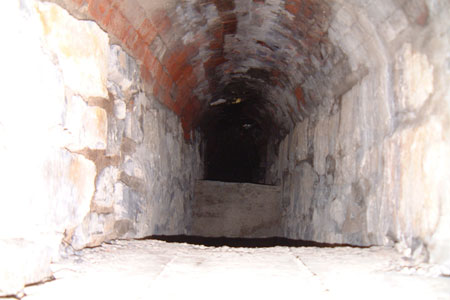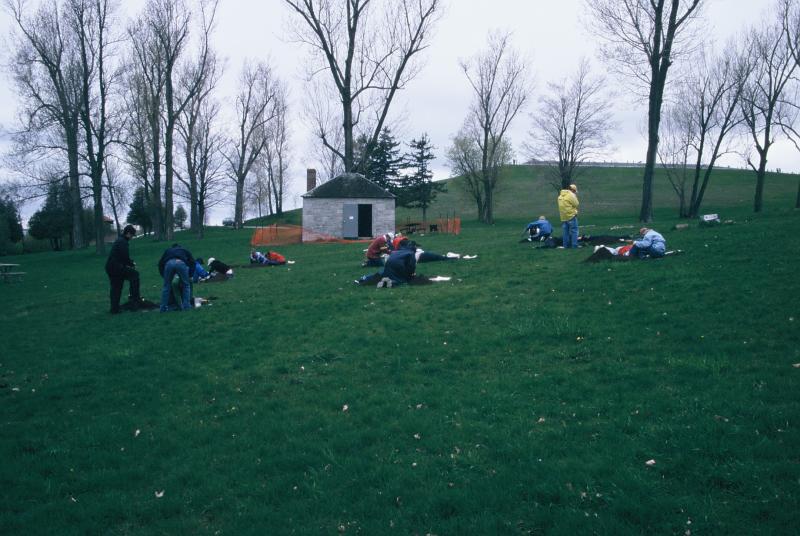-2002.jpg) Sixty-five “Can You Dig It?”© participants excavated at the Fort Henry Garrison Hospital this year. As with the 2000 and 2001 excavations, the site’s location was the east side of Point Henry, near the St. Lawrence River shoreline, with two discrete locations: the Garrison Hospital and the Guard House.
Sixty-five “Can You Dig It?”© participants excavated at the Fort Henry Garrison Hospital this year. As with the 2000 and 2001 excavations, the site’s location was the east side of Point Henry, near the St. Lawrence River shoreline, with two discrete locations: the Garrison Hospital and the Guard House.
In 1827-1828 the Fort Henry Garrison Hospital was built on the east side of Point Henry to complement the army’s Regimental or General Hospital, which was located in the town. Its purpose was to serve the artillery and infantry detachments barracked at Fort Henry, which commanded the height opposite the town and harbour, on the east side of the Cataraqui River. It was situated at some distance from the garrison barracks it served, and it was isolated from the surrounding community by a palisade and guardhouse sentry. The relationship between the isolated hospital site and the fort itself may in fact be reflected in the purpose of the hospital, that of providing isolation from disease on contagion.
When the British garrison marched out in 1870, a permanent Canadian militia was created. Its small size meant the Garrison Hospital became redundant, and it was converted to barracks. It was ultimately abandoned and remained so through the early decades of the 20th century - occasionally visited by RMC cadets on field exercise. At some point the Dead House was demolished. The hospital property was leased by the Department of Militia and Defense to civilians who rapidly populated the shoreline from Cartwright’s Point to Fort Henry with cottages. The stone guardhouse was used by cottagers, but the hospital building itself remained derelict, visited occasionally by transients, and in November 1924 the hospital was destroyed by fire. During the reconstruction of Fort Henry in the mid 1930s the hospital ruins were surveyed with the apparent intention of including it in the overall historic reconstruction, however with the outbreak of WWII and Fort Henry being used as an internment camp, the fire gutted garrison hospital was deemed a nuisance building and demolished.
 While once again the material culture from the site remained sparse, the structural and stratigraphic data and detail has been rather prolific and exciting. We have uncovered the privy drain which has a rather beautifully arched structure in the north-south oriented walls. This is significant in that it appears to tie in with two other drain features noted on the surface at the site, which should help in understanding how drainage was dealt with. Relatively little in the way of 19th century occupation has been observed, while the impacts of the 1936-1938 restoration are evident. Undisturbed contexts reflecting the military occupation of c. 1828-1891 were only encountered towards the end of this season.
While once again the material culture from the site remained sparse, the structural and stratigraphic data and detail has been rather prolific and exciting. We have uncovered the privy drain which has a rather beautifully arched structure in the north-south oriented walls. This is significant in that it appears to tie in with two other drain features noted on the surface at the site, which should help in understanding how drainage was dealt with. Relatively little in the way of 19th century occupation has been observed, while the impacts of the 1936-1938 restoration are evident. Undisturbed contexts reflecting the military occupation of c. 1828-1891 were only encountered towards the end of this season.
Because of the great impact of the fire and subsequent demolition on the hospital remains, it is likely that pockets of evidence of the occupation and use of the hospital remain hidden below the rubble. The exterior of the Guard House has provided the best occupation evidence during the military period as well as information on the condition of the foundations of this existing structure.
remain hidden below the rubble. The exterior of the Guard House has provided the best occupation evidence during the military period as well as information on the condition of the foundations of this existing structure.

-2002.jpg) Sixty-five “Can You Dig It?”© participants excavated at the Fort Henry Garrison Hospital this year. As with the 2000 and 2001 excavations, the site’s location was the east side of Point Henry, near the St. Lawrence River shoreline, with two discrete locations: the Garrison Hospital and the Guard House.
Sixty-five “Can You Dig It?”© participants excavated at the Fort Henry Garrison Hospital this year. As with the 2000 and 2001 excavations, the site’s location was the east side of Point Henry, near the St. Lawrence River shoreline, with two discrete locations: the Garrison Hospital and the Guard House. While once again the material culture from the site remained sparse, the structural and stratigraphic data and detail has been rather prolific and exciting. We have uncovered the privy drain which has a rather beautifully arched structure in the north-south oriented walls. This is significant in that it appears to tie in with two other drain features noted on the surface at the site, which should help in understanding how drainage was dealt with. Relatively little in the way of 19th century occupation has been observed, while the impacts of the 1936-1938 restoration are evident. Undisturbed contexts reflecting the military occupation of c. 1828-1891 were only encountered towards the end of this season.
While once again the material culture from the site remained sparse, the structural and stratigraphic data and detail has been rather prolific and exciting. We have uncovered the privy drain which has a rather beautifully arched structure in the north-south oriented walls. This is significant in that it appears to tie in with two other drain features noted on the surface at the site, which should help in understanding how drainage was dealt with. Relatively little in the way of 19th century occupation has been observed, while the impacts of the 1936-1938 restoration are evident. Undisturbed contexts reflecting the military occupation of c. 1828-1891 were only encountered towards the end of this season. remain hidden below the rubble. The exterior of the Guard House has provided the best occupation evidence during the military period as well as information on the condition of the foundations of this existing structure.
remain hidden below the rubble. The exterior of the Guard House has provided the best occupation evidence during the military period as well as information on the condition of the foundations of this existing structure.